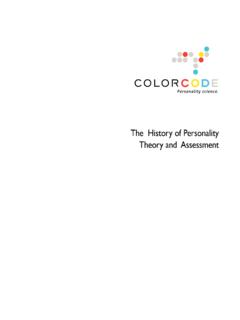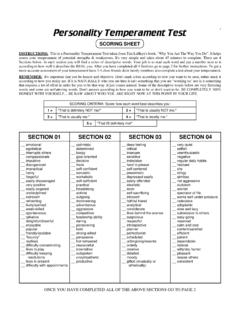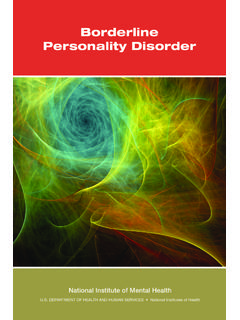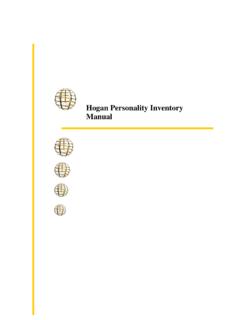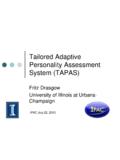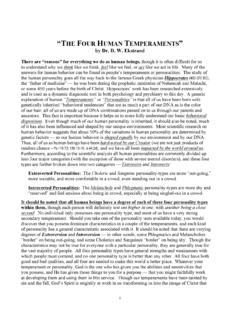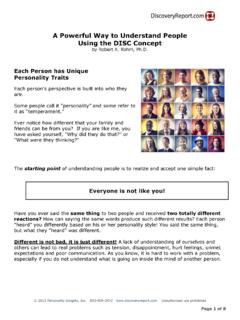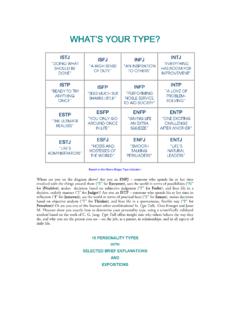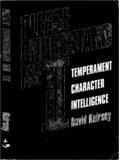Transcription of The History of Personality Theory and Assessment
1 The History of Personality Theory and Assessment Table of Contents 3. Hippocrates through the Middle Eighteenth Century Nineteenth 3. Twentieth 3. Missing the Mark .. 5. History of the Color Motive: The Key to Driving Core 5. Needs and 6. 6. Personality 6. Values and 7. 8. Back to Your 8. Importance of Knowing an Individual's Driving Core Core Motive and Natural 9. The History of Personality Theory and Assessment | 2. Summary Since ancient times, humans have sought to explain behavior by categorizing personalities into distinct types. Personality assessments have been developed over the past several centuries to describe aspects of a person that remain stable throughout a lifetime: the individual's character pattern of behavior, thoughts, and feelings.
2 Personality assessments have been used to sort, classify, and categorize people. References to Personality assessments have even made their way into books and movies such as Harry Potter, who was placed into the Gryffindor House at the Hogwarts School by a sorting hat that could gauge the temperament of each student. Hippocrates through the Middle Ages Hippocrates recorded the first known Personality model, postulating that one's persona is based upon four separate temperaments. Another Greek physician, Galen, extended Hippocrates' Theory by applying a body fluid to each temperament : blood, mucus, black Four Humors: bile and yellow bile, respectively.
3 Different diseases and behaviors had roots in the four Blood humors and the fluid that was dominant was said to be the person's humor. Mucus Black Bile The four humors Theory was to become a prevalent medical Theory for over a millennium Yellow Bile after Galen's death. The Theory experienced widespread popularity throughout the Middle Ages. Eighteenth Century Medicine By the 18th century, medicine was advancing rapidly. The discoveries of the functions of the circulatory, respiratory and digestive systems served to discount the four humors Theory as a realistic practice of medicine.
4 However, it remained important in terms of designating Personality . Nineteenth Century Late 19th/early 20th century physiologist Wilhelm Wundt expounded on the four humors Theory in 1879 and he is noted to be the first person to make clear distinction Four Temperaments: between human body and Personality . Wundt realized that temperaments could not be Sanguine limited to the body fluids. He theorized that four temperaments sanguine, phlegm, Phlegm cholera and melancholy were actually four dimensions of the human Personality Cholera and no individual was completely of one temperament ; rather that everyone typically Melancholy has varying proportions of two or more.
5 He believed that all four temperaments were basic dimensions of the human Personality and that the temperaments fell along axes of changeability and emotionality . Twentieth Century The rapid growth of the field of psychology beginning in the early 20th century led to increased interest regarding individual Personality . The following represent philosophers originating theories at the turn of the century: Sigmund Freud posited a structural model of the mind in which id, ego, and superego (the three components of the human mind) interacted and wrestled with each other for dominance.
6 The result of this constant struggle is the whole of each human's behavior. The History of Personality Theory and Assessment | 3. Eduard Spranger, a German philosopher, theorized four attitudes towards ethical values. He named those attitudes as artistic, religious, theoretic and economic. Henry C. Link wrote a book Employment Psychology. He writes that ideal Personality testing method can be a big machine that received data on one end and sorts the suitable candidates for the specific jobs on the other. The German philosopher presented a Theory of four character styles. He thought that people can be hypomanic, depressive, hyperesthetic or anesthetic depending upon their character styles.
7 Erich Fromm, another German philosopher wrote that there are four human orientation;. exploitative, hoarding, receptive and marketing. Carl Jung, a younger colleague of Freud's, categorized mental functioning again into four principle categories: sensing, intuition, thinking, and feeling. Jung believed that although we could develop all functions, his experience working with clients was that sustainable mental health was the result of using and leading with our natural lead function.. According to Jung's suggestion that there are four fundamental ways we deal with the world: sensing, intuition, thinking, and feeling, we each have a preferred way usually the way we are most comfortable with and best at doing.
8 Myers-Briggs was developed by Katharine Briggs and her daughter Isabel Briggs Myers. They thought that knowing Personality preferences would help women entering the workforce for the first time during WWII choose jobs they were most comfortable and effective doing. The MBTI test takes Jung's Theory and asks questions that do not put people in categories of good or bad. Instead, the outcome from the test encourages people to become more self-aware. Abraham Maslow believed humans are driven to achieve their maximum potential and will always do so unless obstacles are placed in our way.
9 Maslow developed a pyramid called the Hierarchy of Needs, that explains his Theory best. Humans have specific needs that must be met. If lower level needs go unmet, we cannot move up to meet the next level needs. At the lower level we must focus on basic needs such as food, sleep, and safety. If we don't get food or if we go without sleep, it is impossible to focus on the higher level needs such as self-esteem or to reach the level of self-actualization. morality, John B. Watson in responding to theories popular in the early creativity, spontaneity, 20th century, asserted that all things done by organisms, problem solving, lack of prejudice, acceptance of facts Self Actualization including those by humans like acting, thinking and self-esteem, confidence, feeling should be regarded as behaviors.
10 Theorist believe achievement, respect of others, respected by others Esteem that all behaviors are observational whether the actions are friendship, family, sexual intimacy publicly displayed or of a private nature, such as thinking Love/Belonging security of body, of employment, of resources and belief in nurture over nature is a second of morality, of the family, of health, of property Safety fundamental characteristic of behaviorists. They believe that breathing, food, water, sex, sleep, homostasis, excretion Physiological the mind begins as a blank box, so the environment has a singular influence over one's behavior.
